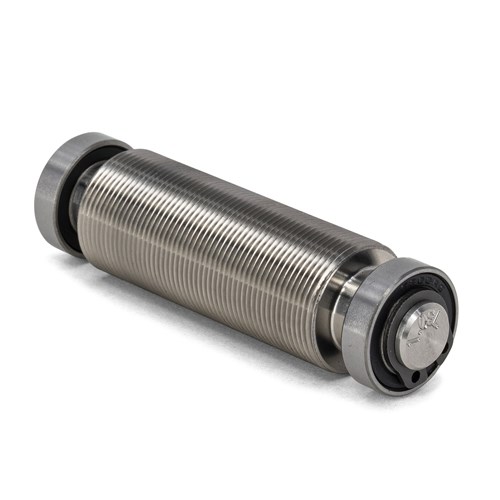- Product number T0410-100SL
- Country of origin:Norway
- Season:Fall/Winter
- Concept:World Cup
1.0mm thread left
Manual structure roll for T0410
- In stock
- Easy rolling
- High quality steel
We do not currently ship to your location
Please contact your local retailer or change your settings below
Product information
Technical specifications
FAQ
- For cold and new snow, the finer the structure
- For wet snow, the coarser the structure
- Beginner: T0423 structure tool with one roller
- Training: T0424S Three-Roller Structure Tool
- Competing: T0410 WC Adjustable Structure Tool
- Beginner: T0423 structure tool with one roller
- Training: T0424S Three-Roller Structure Tool
- Competing: T0410 WC Adjustable Structure Tool
- Beginner: T0423 structure tool with one roller
- Training: T0424S Three-Roller Structure Tool
- Competing: T0410 WC Adjustable Structure Tool
What does sanding and structure mean for cross-country skis?
Quite simply, this means sanding the base of the ski and putting a structure on it. The structure is the pattern in the sole. This is very important for how well the skis glide on different types of conditions.
A coarse structure is suitable for wet conditions and a fine structure is for cold conditions.
There are many different structures, but to make it easy:
The goal with the right structure is to drain the water from the snow so that the ski glides optimally.
Read more here: Comprehensive guide to manually structuring your skis
What is a structure tool used for?
A structure tool allows you to adapt the structure of your ski to the day's conditions.
Adding a manual structure can in many cases give the glider a giant boost. The manual structure is set by a separate filing tool (e.g. T0424S Structure Kit ), which you can buy from us.
The skis must have been glided and polished before you add the manual structure. This is widely used in competitions at the highest level. Usually, you just characterize the ski with a structure you can remove by heating the glide wax, but we have a tool that permanently sets the structure. The T401U Structure tool is a good tool for wet conditions, but remember to sand the skis again to remove it.
All of our structure tools can be found here.
Read more here: Comprehensive guide to manually structuring your skis
Why file cross-country skis?
It is really important for the ski to glide well on the chosen trail and to optimize the structure for the day’s conditions. It is also necessary to get the best glide and performance.
For example, you need:
Video: Swix Racing Filing
Read more here: Comprehensive guide to manually structuring your skis
How do I use a filing iron?
Before the skis are filed, they must be prepared. That is, waxed, scraped and brushed. Pull the filing iron 1–3 pulls from the tip to the rear with increased pressure on the iron from the binding towards the back of the base. The pressure on the iron should be increased in wetter and damper snow.
For example, you need:
Video: Swix Racing Filing
Read more here: Comprehensive guide to manually structuring your skis
How do I choose the right structure for cross-country skis?
A rule of thumb is the wetter the snow, the coarser the texture.
A broken V structure (e.g. 0.5-mm V structure) is a fine structure on colder trails for classic and skating styles, while a 1-mm straight file is a good choice on the rear part of classic skis, especially at -5 degrees and warmer.
Our Filling Table gives you a simple overview of what to choose for different snow types and temperatures. Find the filing table here: Comprehensive guide to manually structuring your skis
Which structure tool should I use as a beginner or expert?
T423 gives a good result and has easily replaceable rollers where it is possible to buy different types of rollers with different structures. This one is made of plastic and will not withstand professional use.
T0410 WC is our latest tool. It is made of metal, is robust and withstands a lot of punishment. It is the first tool that allows you to set the pressure you want on your skis to give you the perfect groove. It is made in Norway.
For example, you need:
Read more here: Comprehensive guide to manually structuring your skis
Can I change the structure of my cross-country skis between each trip?
Yes, if you use a filing tool, where you roll over and emboss (for example, T0424S Three-roll structure tool ) and do not cut (for example, the T401U Structure tool ) into the structure. You need to glide the skis every time you change structure.
Read more here: Comprehensive guide to manually structuring your skis
Do I need to sand the ski to get a new structure?
Are there any filing irons that are more important to have than others?
A 1-mm straight works well on the back of the skis on almost all types of snowy trails, especially on classic skis. Apply more pressure the wetter the snow.
If it is very wet, it may be useful to use 2mm. A 0.5-mm broken V is great for skating and classic skiing in below zero temperatures.
For beginners, these tools cover most trails:
Read more here: Comprehensive guide to manually structuring your skis
For what type of snow and temperature does correct structure/groove become the most important?
The short answer is when it is very wet or very cold.
In cold conditions, you want to create a water film between the snow and the ski. Then you can use a fairly fine broken V structure, while on wet conditions you want to drain. For wet conditions, use a coarse texture.
Read more here: Comprehensive guide to manually structuring your skis
Shipping & returns
Free shipping over 1000 kr or 79 kr under this value.


